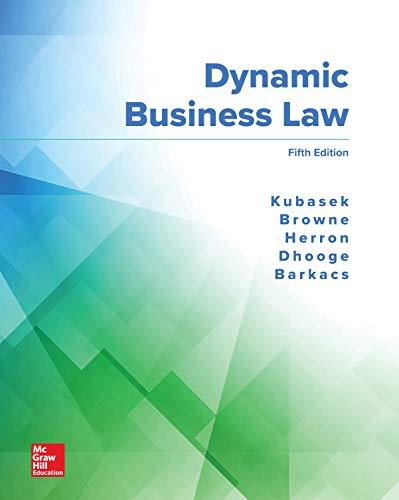Question
9. On May 31, 1978, Cooper Investments, Robert C. Rifkin, and Gerald Kernis (Creditors) sold to Robert L. Conger, Thomas H. Stroh, and Jack W.
9. On May 31, 1978, Cooper Investments, Robert C. Rifkin, and Gerald Kernis (Creditors) sold to Robert L. Conger, Thomas H. Stroh, and Jack W. Welsh (Guarantors) all of the outstanding shares of stock in a corporation which owned the assets of a certain restaurant and bar. In exchange, the Creditors were given a promissory note in which the corporation promised to pay the Creditors the principal sum of $450,000 together with interest at the rate of 8 percent per annum. The note called for payment of principal and interest in sixty-seven monthly installments. The Guarantors furnished the Creditors with a separate written guaranty, which provided that they jointly and severally guaranteed "the prompt payment of the note." The guaranty further provided that it was continuing and extended "to any note given in extension or renewal of this note notwithstanding the original note may have been surrendered, provided the liability of the [guarantors] shall not be increased over the amount contained in the original note."
In November 1979, the Guarantors sold the corporation to the third party and were no longer involved in operating the restaurant and bar or in the management of the corporation. In October 1981, the corporation entered into a joint venture agreement with Iona, Inc., concerning the operation of the restaurant and bar. In September 1982, the president of Iona approached the Creditors about a change in the payment terms of the note. They reached an oral agreement to reduce the monthly payments of principal and interest from $8,000 to $5,000 per month for eight months and also to increase the rate of interest from 8 percent to 12 percent per annum. After May 1983, no further payments were made on the note. Iona later defaulted on the note and the Creditors brought suit against Guarantors. The trial court rejected the Guarantors' affirmative defenses and entered judgment jointly and severally against them. The Guarantors appealed. Did the underlying changes in the promissory note serve to discharge the Guarantors from further liability? Why or why not? [Cooper Investments v. Conger, 775 P. 2d 76 (Colo. App. 1989).]
Please give detailed answers and references. Thank you!
Step by Step Solution
There are 3 Steps involved in it
Step: 1

Get Instant Access to Expert-Tailored Solutions
See step-by-step solutions with expert insights and AI powered tools for academic success
Step: 2

Step: 3

Ace Your Homework with AI
Get the answers you need in no time with our AI-driven, step-by-step assistance
Get Started


